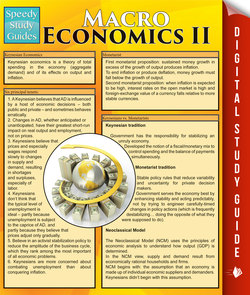Читать книгу Macro Economics ll (Speedy Study Guides) - Speedy Publishing - Страница 2
ОглавлениеKeynesian Economics
Keynesian economics is a theory of total spending in the economy (aggregate demand) and of its effects on output and inflation.
Six principal tenets:
1. A Keynesian believes that AD is influenced by a host of economic decisions – both public and private – and sometimes behaves erratically.
2. Changes in AD, whether anticipated or unanticipated, have their greatest short-run impact on real output and employment, not on prices.
3. Keynesians believe that
prices and especially
wages respond slowly
to changes in supply
and demand,
resulting in
shortages and
surpluses,
especially
of labor.
4. Keynesians
don’t think that the
typical level of
unemployment is
ideal – partly because
unemployment is
subject to the caprice of
AD, and partly because they believe that prices adjust only gradually.
5. Believe in an activist stabilization policy to reduce the amplitude of the business cycle, which they rank among the most important of all economic problems.
6. Keynesians are more concerned about combating unemployment than about conquering inflation.
Monetarist
First monetarist proposition: sustained money growth in excess of the growth of output produces inflation.
To end inflation or produce deflation, money growth must fall below the growth of output.
Second monetarist proposition: when inflation is expected to be high, interest rates on the open market is high and foreign-exchange value of a currency falls relative to more stable currencies.
Keynesians vs. Monetarists
Keynesian tradition
Government has the responsibility for stabilizing an
unruly economy.
Developed the notion of a fiscal/monetary mix
to control spending and the balance of payments simultaneously.
Monetarist tradition
Stable policy rules that reduce variability and uncertainty for private decision makers.
Government serves the economy best by enhancing stability and acting
predictably, not by trying to engineer
carefully-timed changes in policy actions
(which is frequently destabilizing . . . doing the opposite of what they were supposed to do).
Neoclassical Model
The Neoclassical Model (NCM) uses the principles of economic analysis to understand how output (GDP) is determined.
In the NCM view, supply and demand result from economically rational households and firms.
